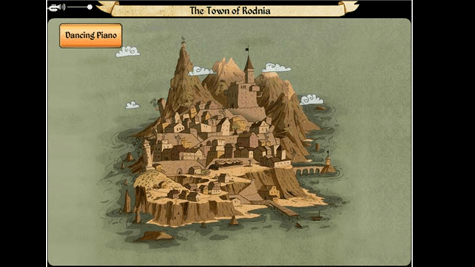More Than Mere Child’s Play
Misfortune is a Steampunk RPG completely drawn by a children’s book illustrator. Even if that is not the player’s favorite style of art, it does not at all look bad.
The game starts out with a narrative dialogue (and be warned…the game features a lot of them) wherein the player is told that he has saved a girl when she slips off of the ship The Steaming Tea Cup. He is awakened by his aunt from his daydream and decides to take a breath up on the deck. But of course, he slips and awakens again on a nameless island near a town called Rodnia wherein he decides to check out the surrounding area. It immediately becomes clear that it isn’t a safe town.
Misfortune is intended to be a casual RPG and to be played in doses of 20-30 minutes.
Sometimes, whilst doing a mission, random NPCs on the street will engage the player in various conversations, challenging you to a game of poker, for example.

Moments later, huge flying robots appear, though they don’t engage the player. In a local bar, the player encounters a hot barmaid named Michelle, whom he knows from before (at least, that’s what the game says). The story progresses along these lines. Though it may seem that not everyone would be interested in a game that plays like this, it is worth trying if only for the humor.
The Chart of the Matter
What is displayed in the image above is basically what the game looks like. The player is controlled using the the WASD keys, or the on-screen arrows to walk through the streets of Rodnia. A display shows an inventory bag, diary, pouch, map, apple count and medicine count at the bottom of the screen. Click on any of them to use or open them. On the right side of the screen, a representation of the player character can be seen. Below the character info, you can find the standard combat skills and RPG-type skills.

How to boost these traits isn’t revealed until later in the game. Upgrades must be purchased from Gustav, who seems to be a trainer. Most upgrades cost six Skill Points. Skill Points and gold are earned by completing missions.
After a short while, and some intense “manning up,” the player character can look like this:

It might not be too much of an improvement, but better than no pan or stick at all, right?
The main character looks to be a child of about twelve years with a bad taste in clothing. In the dialogs that the game presents, he talks like a tough guy, or at least tries to talk like one. He also likes hanging out in the bar and drinking, so the actual age of the character remains remains unclear.
Eventually the player reaches an overview screen, which is beautifully drawn, yet sort of low quality. It is a rough view of the town. As the player progresses further into the game, more buttons will be added on this overview, including the main character’s house and a shop. On the top, there is a location named Dancing Piano. From here, the player can start quests to gain money and experience. Before the player can accept missions, he must have earned enough mission credits. In the present version of the game, it seems though the game awards a mission credit for every six hours of play. You start off with six, but more can be purchased. They will also accumulate after enough time has elapsed.

Click the Bar icon to bring up the quest screen and select the desired difficulty level (for example, a level 0 difficulty quest that involves map-making). While doing that, the player will still be required to dispatch foes such as giant squirrels and dogs. Quest completed! The reward for such a quest is ten coins. Now the overview screen looks less sparse. Adding a home, or a “Stuff for Sale” plate to one’s overview screen opens even more options from which to choose. This grinding process of completing missions goes on for a while, but of course the quests keep getting harder and different tasks require fulfillment.
The Lost Boys
The music of the game isn’t bad, but it gets repetitive after a while. There just isn’t much variety to speak of. Also, the perspectival design of the levels can tend to become a little bothersome; moving ahead makes it seem as if each move takes the player a meter ahead, should the player turn around, obstacles that just stood right next to the wall now appear to be a few meters away. If the map isn’t used wisely, navigating it becomes very difficult. From the perspective of someone who enjoy games like Misfortune, this game is not bad, but does still need some work. The movement issues need to be addressed, as it can be tediously disorienting.
The music fits the pirate theme and the rather child-like quality of the game. I have no real complaints in terms of the graphics, especially considering the fact that an illustrator for children’s books created all the art for the game. The real focus of Misfortune is the plot; Multiple stories get twisted into one big, complex story.
Taking everything in consideration, I give this game a 2 out of 5. But keep in mind, this game is still in the beta stage! If the designers address a lot of the issues, Misfortune could become great one day.
[xrr rating=”2/5″]





Woah, I am getting addicted to this one!
Haha Cool, Id like to hear your opinion on it if you got time. (Comment plz 😛 )